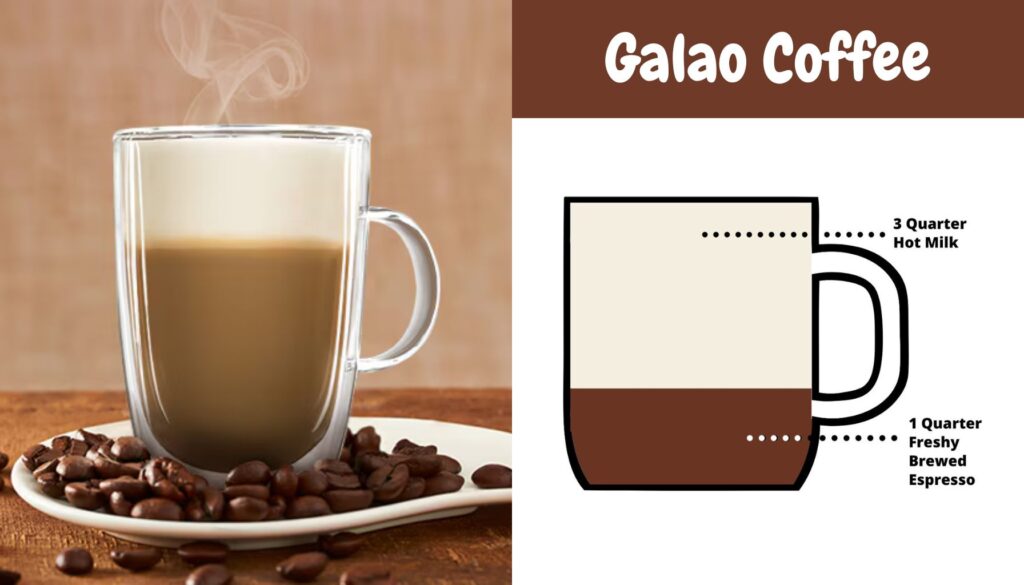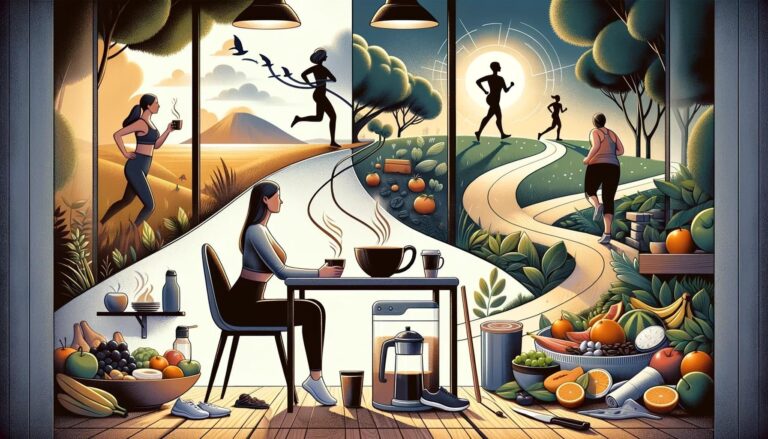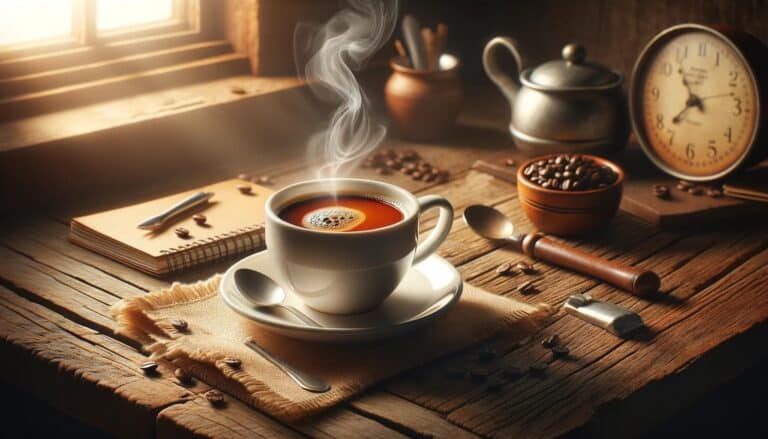People in Portugal love their Galão, a coffee drink known for its smooth, creamy feel and deep, rich taste. The Galão mixes espresso and frothed milk in a special way, making it different from other coffee drinks around the world. It’s usually served in a tall glass, showing off its pretty layers and inviting everyone to enjoy its cozy warmth.
The Galão comes from Portugal’s lively coffee scene and has become a favorite in cafes and homes all over the country. It’s more than just a drink in Portugal; it’s part of enjoying long, relaxing coffee breaks, often with pastries or snacks. This shows how much Portuguese people love coffee and their knack for blending simple things with great flavor.
As more and more people try the Galão, its fame is spreading far beyond Portugal, winning over coffee lovers worldwide. Yet, the Galão is still very much a symbol of Portuguese food culture and the country’s love for top-notch coffee. Portugal has given the world a unique way to enjoy coffee with the Galão, a drink to savor slowly and remember with a smile, reflecting the easygoing and friendly vibe of Portuguese life.
The Basics of Galão

What is a Galão?
The Galão is a Portuguese coffee drink that elegantly combines espresso with frothed milk in a specific proportion, typically one part espresso to three parts frothed milk. This ratio distinguishes the Galão, resulting in a beverage that is milder than a straight espresso but richer and with more coffee flavor than other milk-based coffee drinks. Served in a tall glass, the Galão showcases a pleasing visual gradient from the dark espresso at the bottom to the creamy, frothy milk on top, making it as appealing to the eye as it is to the palate.
Comparison with Similar Coffee Drinks
Café Latte: One of the closest relatives to the Galão is the café latte, which is popular around the world. While both drinks share a foundation of espresso and steamed milk, lattes typically have a higher coffee to milk ratio and are served in a wider cup or bowl to accommodate latte art on the frothy surface.
Cappuccino: The cappuccino is another well-known coffee drink, comprising equal parts espresso, steamed milk, and milk foam. Cappuccinos are much foamier than Galãos and are served in smaller cups, focusing on a stronger coffee flavor with a velvety texture.
Flat White: Originating from Australia or New Zealand (the exact origin is hotly debated), the flat white is similar to a Galão in its emphasis on coffee, using a higher ratio of espresso to milk. The key difference lies in the texture of the milk; flat whites use microfoam (steamed milk with fine, velvety bubbles) to create a smooth, glossy layer that integrates more closely with the espresso.
Café au Lait: The French café au lait is another cousin, traditionally made with equal parts brewed coffee (not espresso) and steamed milk. Served in a wide bowl or cup, the café au lait offers a different coffee experience, with a lighter coffee flavor and more milkiness compared to the Galão.
The Galão, with its unique espresso to milk ratio and serving style, occupies a special place in the coffee world, offering a distinctly Portuguese take on the espresso and milk combination. Its balance of richness and smoothness makes it a favorite among those who appreciate the nuanced flavors of coffee coupled with the creamy luxury of frothed milk.
Historical Background

The Galão, a key part of Portuguese coffee culture, has a rich history tied to Portugal’s love for coffee and its global adventures. Its story, though not pinned down to exact dates, starts with Portugal’s deep-rooted café society and the global coffee trade.
The Story of the Galão in Portuguese Coffee Culture
Portuguese explorers and traders set out in the 15th and 16th centuries, during the Age of Discovery, making their way to Africa, Asia, and the Americas. They brought back many exotic items, including coffee, which quickly became a favorite drink. By the 18th century, coffee houses were popping up in Lisbon and Porto, turning into popular spots for intellectuals, artists, and the well-to-do. It’s in this coffee-loving setting that the Galão probably first showed up, as the Portuguese mixed their own traditions with those they learned from around the world.
While no one knows exactly when the Galão started, many think it was inspired by the Italian latte or French café au lait, but with a Portuguese twist. It suited the Portuguese taste for a gentler coffee drink enjoyed slowly, often with breakfast or in the afternoon, highlighting the Portuguese way of taking life easy and valuing time with others.
How the Galão Has Changed Over Time
The Galão has always been a tall glass of coffee with smooth, frothy milk, but how people make and drink it has changed over time because of new coffee-making technology, changing tastes, and social shifts.
Technological Advances: Modern espresso machines and steaming tech have made the Galão even better. Where it might have once been made with simple coffee pots and separately heated milk, baristas now use precise methods to whip up the perfect espresso and microfoam milk that make a Galão stand out.
Cultural Shifts: Coffee shops and cafes in Portugal have evolved from elite meeting spots to places where anyone can hang out, broadening the Galão’s appeal across society.
Globalization: As Portugal has joined the global community, the Galão has spread worldwide, picked up by coffee lovers everywhere. This global fanbase has brought small changes in how the Galão is made and served, allowing it to cater to varied tastes while keeping its Portuguese soul.
Through all these changes, the Galão has stayed a beloved emblem of Portuguese coffee culture, representing the country’s historical adventures, its openness to the world, and its dedication to holding onto tradition while welcoming new ideas.
How to Make a Galão

Making a Galão at home is a delightful way to bring a taste of Portugal into your kitchen. With the right ingredients and a bit of practice, you can enjoy this creamy, comforting coffee drink any time. Here’s how to make the perfect Galão.
Ingredients Needed
- Freshly ground coffee beans suitable for espresso
- Cold milk (whole milk is traditional for a richer flavor, but any type can be used)
- Water
Equipment Needed
- Espresso machine or coffee maker capable of making espresso
- Milk frother or steaming wand
- Tall glass (about 8-12 ounces)
Step-by-Step Preparation Guide
- Prepare the Espresso: Start by making a single or double espresso, depending on your preference for coffee strength. For a single espresso, use about 7-9 grams of coffee; for a double, use 14-18 grams. Brew the espresso directly into your tall glass.
- Froth the Milk: While your espresso is brewing, begin frothing your milk. If you’re using a steaming wand, heat the milk until it’s about 150-155 degrees Fahrenheit, creating a smooth, velvety foam. If you don’t have a steaming wand, you can use a handheld milk frother or even heat the milk gently on the stove and whisk vigorously to create foam.
- Combine Espresso and Frothed Milk: Once your milk is frothed, gently pour it into the glass with the espresso, aiming for a ratio of approximately one part coffee to three parts milk. The ideal Galão will have a layer of frothed milk on top, but the majority of the drink should be a warm, creamy mix of coffee and milk.
- Serve Immediately: The Galão is best enjoyed fresh and hot. Serve it as is, without any additional sweeteners or flavors to truly appreciate the balance of espresso and milk.
Tips for Making the Perfect Galão at Home
- Coffee Quality: Use high-quality, freshly ground coffee beans. The espresso is the foundation of your Galão, so the better the coffee, the better the drink.
- Milk Temperature: Be careful not to overheat the milk. Overheating can affect the flavor and ruin the texture of the foam. Aim for a temperature that’s hot but still comfortable to touch.
- Milk Frothing: Achieving the right froth is crucial for a Galão. The foam should be smooth and velvety, not too airy or stiff. This creates the creamy texture that characterizes the drink.
- Ratios: While the traditional ratio is one part espresso to three parts milk, feel free to adjust according to your taste preference. Some might prefer a stronger coffee flavor, while others might enjoy a milkier version.
- Experiment: Once you’ve mastered the basic Galão, don’t be afraid to experiment. Try different types of milk, adjust the coffee strength, or even add a hint of cinnamon or cocoa powder on top for a personalized touch.
With these guidelines, you’re well on your way to enjoying a delicious Galão at home, bringing a little piece of Portuguese coffee culture into your daily routine.
Serving and Enjoyment

Traditional Ways to Serve Galão
The Galão is traditionally served in a tall, clear glass that allows its beautiful layers to be displayed, from the rich espresso at the bottom to the creamy, frothed milk on top. This not only makes the Galão a feast for the eyes but also allows drinkers to appreciate the delicate balance between the espresso and milk as they enjoy their drink. The glass is usually placed on a small saucer with a spoon on the side, allowing consumers to stir their Galão if they wish to mix the layers further. In Portugal, it’s common to serve the Galão with a packet of sugar on the side, allowing individuals to sweeten their drink to taste.
Best Times and Occasions for Enjoying Galão
The Galão is a versatile drink, perfect for various occasions and times of the day. Traditionally, it is most often enjoyed in the morning as a gentle wake-up call, accompanying breakfast or a light pastry. The smooth, creamy nature of the Galão makes it an ideal coffee choice for those who prefer a milder start to their day compared to a robust espresso.
However, the Galão’s appeal is not limited to the morning. It can also be savored during the afternoon, especially as a relaxing break or during social gatherings. The drink’s comforting nature makes it perfect for leisurely sipping while catching up with friends or reading a book.
In Portugal, coffee breaks are an important part of the day and cultural ritual, making the Galão a popular choice for these moments of pause and enjoyment, regardless of the time.
Pairing: What to Eat with Galão
The Galão pairs wonderfully with a variety of foods, enhancing both the drink and the dining experience. Here are some classic pairings:
- Pastéis de Nata: These famous Portuguese custard tarts, with their flaky pastry and creamy, sweet filling, are a heavenly match for the creamy Galão. The contrast between the sweet tart and the mild coffee is perfect at any time of day.
- Toast or Sandwiches: For a more substantial breakfast or snack, the Galão goes well with toast spread with jam or butter, or with simple sandwiches. The coffee’s warmth and milkiness complement the crispiness of the toast and the savory flavors of the sandwiches.
- Bolos e Doces (Cakes and Sweets): In Portugal, coffee time is often sweet time. A slice of cake, a sweet pastry, or even a simple biscuit are all enhanced by the smooth, creamy nature of the Galão. The coffee’s mildness allows the flavors of the sweets to shine without overpowering them.
- Savory Pastries: Savory options like croissants filled with ham and cheese or other savory pastries also pair nicely with the Galão. The combination of the savory food and the slightly sweet, milky coffee creates a satisfying balance.
The key to pairing with a Galão is to consider the balance of flavors. Since the Galão is milder and creamier than many other coffee drinks, it pairs best with foods that complement rather than overpower its delicate taste. Whether you’re enjoying a sweet treat, a light breakfast, or a savory snack, the Galão is a delightful accompaniment, enhancing the overall gastronomic experience.
Galão Around the World

The Galão, a cherished staple of Portuguese coffee culture, has transcended its local roots, finding a place in the global coffee scene. As it ventures beyond Portugal, the Galão inspires new variations and adaptations, integrating into different cultures and palates while maintaining its essence. This global journey not only showcases the versatility of coffee but also illustrates the dynamic nature of culinary exchange.
Variations of Galão in Different Countries
Brazil: In Brazil, a country with its own rich coffee culture and history, the Galão has inspired variations like the “café com leite” (coffee with milk), which is more similar to the Galão in terms of milk to coffee ratio, albeit often made with regular coffee instead of espresso.
Italy: The Italian “Latte” bears a resemblance to the Galão, with a focus on espresso and steamed milk. However, Italian variations might emphasize the espresso’s strength more, reflecting Italy’s deep espresso culture.
United States and Canada: In North America, the “Latte” is perhaps the closest counterpart to the Galão, though the specific ratios of espresso to milk can vary greatly from one café to another. Specialty coffee shops might offer drinks that closely resemble the Galão, sometimes under different names or with slight modifications to cater to local tastes.
Australia and New Zealand: The “Flat White” is a popular choice in these countries, emphasizing a higher ratio of coffee to milk and a focus on the texture of the milk. While not identical, the Flat White shares the Galão’s appreciation for a balanced, nuanced coffee experience.
The Global Spread of Portuguese Coffee Culture
The global appreciation for the Galão reflects a broader interest in Portuguese coffee culture and culinary traditions. Portuguese expatriates and travelers have played a significant role in introducing the Galão to new audiences, often bringing their coffee preferences and preparation styles with them. Additionally, the rising popularity of specialty coffee shops around the world has fostered a curiosity for different coffee traditions, with the Galão serving as a delicious ambassador of Portuguese coffee culture.
How Galão is Adapting to New Tastes and Trends
As the Galão meets different cultures and palates, it naturally adapts to fit new tastes and trends. Here are a few ways in which the Galão is evolving:
- Alternative Milks: With the rise in popularity of dairy-free diets, many cafes now offer Galão with alternative milks like almond, oat, soy, or coconut milk, catering to a broader range of dietary preferences and introducing new flavor profiles.
- Flavor Infusions: Experimentation with adding flavors to the Galão, such as vanilla, caramel, or cinnamon, is becoming more common, appealing to those who enjoy personalized coffee experiences.
- Sustainability Practices: As environmental consciousness grows, the Galão is also being prepared with more attention to sustainability, including the use of organic coffee beans, locally sourced milk, and eco-friendly serving practices.
The Galão’s journey from a Portuguese classic to a beverage enjoyed around the world is a testament to the universal appeal of coffee and the rich cultural exchanges that food and drink can facilitate. As it continues to adapt and evolve, the Galão remains a cherished link to Portuguese traditions, bringing a taste of Portugal to coffee lovers everywhere.
The Cultural Significance of Galão

The Galão is more than just a coffee drink; it is a cultural emblem that embodies the essence of Portuguese daily life, social customs, and national identity. Its significance goes beyond its ingredients, representing a ritual that brings people together, a moment of pause in the rush of daily life, and a testament to the rich culinary heritage of Portugal.
Galão in Portuguese Daily Life
In Portugal, the Galão is not just a morning beverage; it’s a staple throughout the day, reflective of the Portuguese approach to life that values relaxation and social connections. Mornings often begin with a Galão, enjoyed leisurely at home or at a local café, accompanied by a light breakfast. This ritual sets the tone for the day, emphasizing a slow start and appreciation for the moment.
The tradition of “lanche,” a mid-afternoon snack, is another perfect occasion for a Galão, where it’s savored as a break from the day’s activities, often accompanied by pastries or sandwiches. The Galão facilitates a moment of leisure and reflection, whether it’s a solitary break or a time to engage with friends and family.
The Role of Coffee Shops in the Popularity of Galão
Coffee shops and cafés play a central role in the cultural landscape of Portugal, serving as social hubs where people from all walks of life gather. These establishments are not just places to consume beverages; they are venues for community interaction, business meetings, and leisurely conversations. The popularity of the Galão is intricately linked to these social spaces, with its presence on nearly every coffee shop menu reflecting its importance in Portuguese coffee culture.
Coffee shops have also been instrumental in evolving the tradition of the Galão. They provide a space where traditions are upheld, and innovations are embraced, allowing for the Galão to be continuously rediscovered and appreciated by new generations.
Galão and Portuguese Identity
The Galão is a reflection of Portuguese identity, embodying values such as community, leisure, and the importance of savoring life’s simple pleasures. Its widespread consumption speaks to a national love for coffee, while its specific preparation and enjoyment reflect Portugal’s unique contributions to global coffee culture.
Furthermore, the Galão represents the Portuguese spirit of hospitality and warmth. Offering a Galão to guests is a common gesture of welcome, symbolizing friendship and generosity. This aspect of sharing and community is central to Portuguese identity and is vividly expressed through the country’s coffee culture.
In the global context, the Galão serves as a culinary ambassador for Portugal, showcasing the country’s rich culinary traditions and its people’s passion for coffee. As the Galão finds its place in the world, it carries with it the stories, traditions, and values of Portugal, inviting people everywhere to share in a piece of Portuguese life.
Through the daily ritual of enjoying a Galão, the social gatherings in coffee shops, and the incorporation of this beverage into moments of hospitality, the Galão continues to be a vital thread in the fabric of Portuguese culture, connecting the past with the present and the local with the global.
Conclusion
The Galão, with its harmonious blend of espresso and frothed milk, stands as a testament to the rich coffee culture of Portugal, embodying the country’s culinary tradition, social habits, and identity. Its significance extends beyond the realm of a mere beverage; it is a cultural icon that encapsulates the essence of Portuguese life—slow, savored, and shared.
Importance and Uniqueness of Galão
The importance of the Galão lies in its ability to represent the Portuguese approach to life: an appreciation for moments of leisure, the value of community, and the pleasure found in life’s simple joys. Its unique preparation and presentation, serving espresso softened with a generous amount of frothed milk in a tall glass, distinguishes the Galão not just as a coffee drink but as an experience. This ritualistic aspect of enjoying a Galão, whether alone as a morning ritual or shared among friends in the afternoon, highlights the social fabric of Portuguese society, where coffee is a medium for connection and conversation.
The Enduring Appeal of Galão in Portugal and Beyond
In Portugal, everyone loves the Galão, from the busy cafes of Lisbon and Porto to the quiet kitchens in the countryside. Its versatility and comforting feel make it a favorite drink for people of all ages and for any moment. As Portuguese culture travels around the world, so does the love for the Galão, introducing folks everywhere to the taste of Portuguese coffee. It keeps up with new trends, like using different kinds of milk or adding new flavors, making sure the Galão stays popular in the ever-changing world of food.
The Galão’s journey from a local favorite to a worldwide hit shows how much everyone loves coffee and how a simple drink can bring different cultures together. It brings the warmth of Portuguese hospitality, inviting everyone to enjoy a tradition that’s both timeless and fitting for today.
Thinking about the Galão’s place in the world, it’s clear its charm comes from more than just its flavor. It symbolizes Portugal’s rich past, lively present, and welcoming spirit. The Galão is more than a drink; it’s a celebration of life’s simple moments. It reminds us to stop, enjoy, and connect with others, a feeling that people all over the world appreciate. This makes the Galão a treasured drink, not just in Portugal, but everywhere.
Frequently Asked Questions About Galão
1. What makes Galão different from a Latte?
The Galão is a Portuguese coffee drink that typically features a lighter espresso to milk ratio compared to a Latte, with about one part espresso to three parts frothed milk, served in a tall glass to showcase its layers.
2. Can I make a Galão without an espresso machine?
Yes, while traditionally made with espresso, you can use a strong brew of coffee as a substitute. The key is to maintain the coffee to milk ratio and to froth the milk to achieve the creamy texture characteristic of a Galão.
3. Is Galão always served hot, or can it be made iced?
Traditionally, Galão is served hot, but an iced version can be made for a refreshing twist. Simply chill the espresso and milk separately before combining them over ice.
4. What is the best time of day to enjoy a Galão?
In Portugal, Galão is enjoyed throughout the day, but it is particularly popular in the morning or during the afternoon as a leisurely break, often accompanied by pastries or light snacks.
5. How has the Galão adapted to global coffee trends?
As the Galão has gained popularity outside of Portugal, it has adapted to include variations like using alternative milks for dietary preferences and adding flavorings such as vanilla or cinnamon to cater to different palates.






